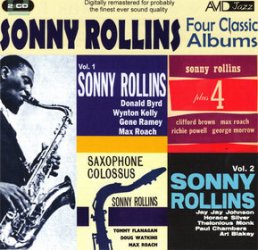Sonny Rollins – Four Classic Albums (2011)
Sonny Rollins – Four Classic Albums (2011)

CD 1: Sonny Rollins Plus 4 1. Valse Hot 2. Kiss And Run 3. I Feel A song Coming On play 4. Count Your Blessings Instead Of Sheep 5. Pent-Up House Sonny Rollins Volume 1 6. Decision 7. Bluesnote 8. How Are Things In Glocca Morra? 9. Plain Jane 10. Sonnysphere Sonny Rollins Volume 2: 11. Why Don't I CD 2:: Sonny Rollins Vol. 2 cont. 1. Wail March 2. Misterioso 3. Reflections 4. You Stepped Out Of A dream 5. Poor Butterfly Saxophone Colossus 6. St. Thomas 7. You Don't Know What Love Is 8. Strode Rode play 9. Moritat 10. Blue Seven Personnel: Sonny Rollins - Tenor sax Clifford Brown - Trumpet (tracks I/1-5) Richie Powell - Piano (tracks I/1-5) George Morrow - Bass (tracks I/1-5) Max Roach - Drums (tracks I/1-10, II/6-10) Donald Byrd - Trumpet (tracks I/6-10) Wynton Kelly - Piano (tracks I/6-10) Gene Ramey - Bass (tracks I/6-10) J. J. Johnson - Trombone (tracks I/11, II/1-5) Horace Silver - Piano (tracks I/11, II/1, 4, 5) Thelonious Monk - Piano (tracks II/2, 3) Paul Chambers - Bass (tracks I/11, II/1-5) Art Blakey - Drums (tracks I/11, II/1-5) Tommy Flanagan - Piano (tracks II/6-10) Doug Watkins - Bass (tracks II/6-10)
Another bargain reissue from the Avid label, containing four remastered LPs from the mid-fifties, transferred to a double CD for around Ł7. They illustrate how Sonny Rollins was a man with so much ability that he sometimes seemed uncertain which direction to take, as so many paths were open to him. For example, note the difference in styles between the first two tracks on the second CD: Wail March is supple and speedy, while Misterioso is gruff and pensive.
The first of the four albums is Sonny Rollins Plus Four from 1956, with the same line-up as the Max Roach/Clifford Brown Quintet of the time. Completed by pianist Richie Powell (Bud Powell's younger brother) and bassist George Morrow, this was a superb group. It demonstrated not only Sonny's brilliance as an exponent of the tenor saxophone but also as a composer with the lilting Valse Hot and the see-sawing Pent-Up House.
Rollins was also the composer of four of the five tracks on the next album - Sonny Rollins Vol. 1. Max Roach was again on drums but the rest of the group was trumpeter Donald Byrd, pianist Wynton Kelly and bassist Gene Ramey. This album illustrates another Rollins quirk: taking a popular song like How Are Things in Glocca Morra? and exploring its jazz capabilities. Here the tune is given exactly the right delicate ballad expression, with Rollins seemingly savouring the rich sound he makes.
The third album - Sonny Rollins Vol. 2 - was recorded in 1957 with an intriguing choice of two contrasting pianists. Horace Silver plays for three of the five tracks but the other two feature Thelonious Monk leading the way through his own compositions, Misterioso and Reflections. The two pianists make their respective tracks entirely different from one another. Art Blakey's forceful drumming adds a lot to the attack of these tracks.
Going back to 1956, the final album - Saxophone Colossus - has always been regarded as one of Rollins' major achievements, and I can't argue with this assessment. Backed only by a rhythm section of Tommy Flanagan, Doug Watkins and Max Roach, Sonny had plenty of room to reveal his burgeoning talents. The album opened with the first-ever recording of St Thomas, the catchy calypso which became closely associated with Rollins. Its rhythmic cheerfulness contrasts with the following You Don't Know What Love Is, a brooding ballad. Notes seem to pour out of Rollins in a continuous stream of imagination, which sometimes takes him into double tempo. Strode Rode reminds us of Sonny's bebop background. Moritat is another name for Mac the Knife, which Rollins and Flanagan take at a leisurely pace, and Max Roach plays a solo using some of his familiar drum patterns. The closing Blue Seven sounds like simplicity itself, with a double-bass pattern over which Rollins lays down an imaginative solo. This is the sort of artistry that seems simple but is in fact very complicated.
This compilation would be a bargain at twice its price - and it shows why Sonny Rollins was (and still is) one of the jazz masters. --- Tony Augarde, musicweb-international.com
download (mp3 @160 kbs):
uploaded yandex 4shared mega mediafire solidfiles zalivalka cloudmailru oboom
Last Updated (Wednesday, 06 May 2015 13:21)








